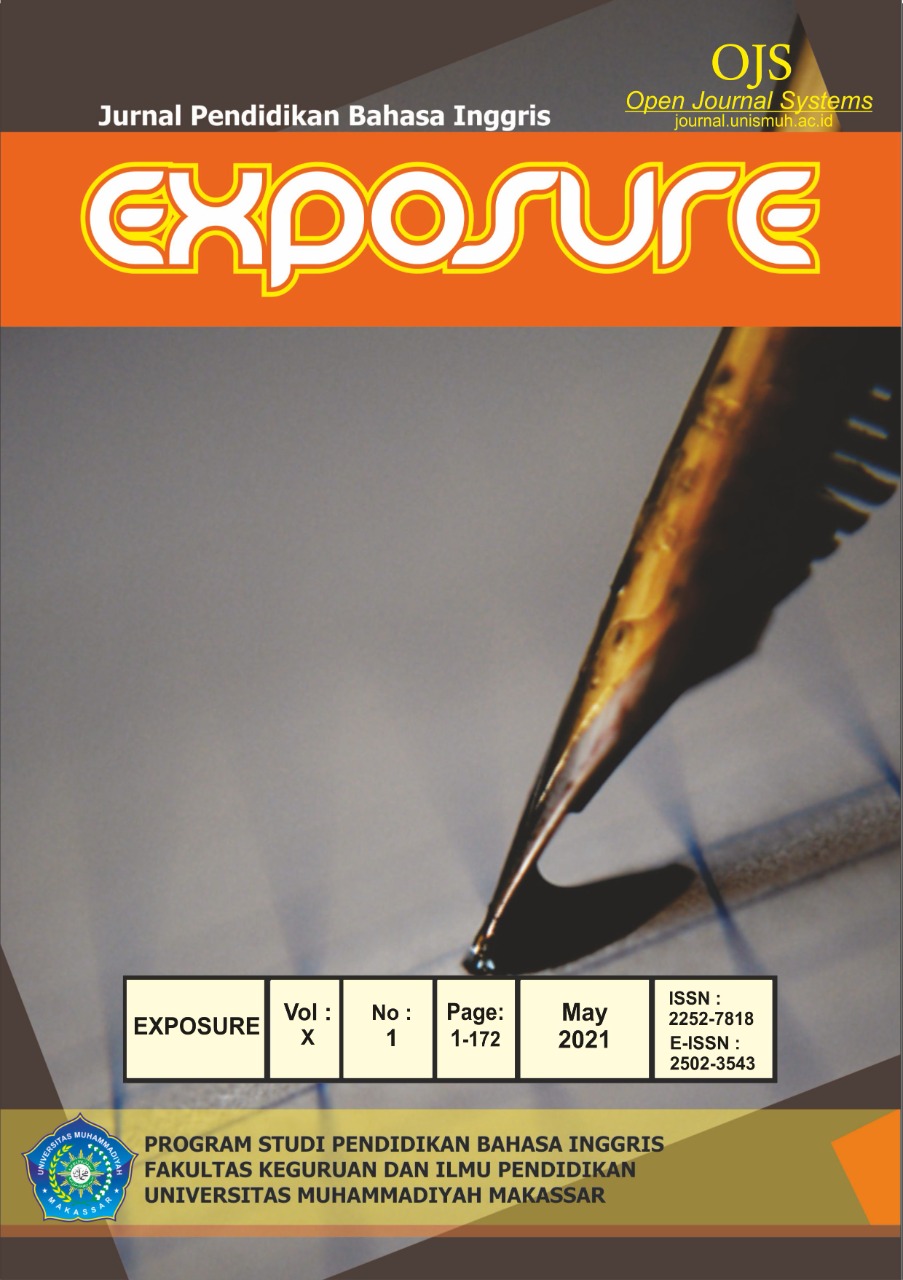PLOT GENERATOR AS DIGITAL TOOL IN ASSISTING THE TEACHER IN WRITING ACTIVITY
DOI:
https://doi.org/10.26618/exposure.v10i1.5070Keywords:
Plot Generator, Digital Tool, Writing Activity.Abstract
This research aims to know how Plot Generator in assisting the teacher in a writing activity.This research used survey research design with quantitative method. Three English teachers participated as subjects of the research in senior high education in BARRU. The steps of collecting data were conducted by observation and questionnaire, The observation was conducted by distributed questionnaires to guide data as prior knowledge before conducting research. Questionnaire as the instrument of the research to gain the information related plot generator in assisting teacher in writing activity. The data were analyzed by using Likert Scale that presented by quantitative data. The results of this study indicate that Plot Generator assists the teacher in a writing activity by assist of function, source and content that is presented by teachers’ perception toward Plot Generator.
References
Afrianto. (2018). Being a Professional Teacher in the Era of Industrial Revolution 4.0: Opportunities, Challenges and Strategies for Innovative Classroom Practices Afrianto Faculty of Teachers Training and Education (FKIP), Universita. English Language Teaching and Research, 2(1), 1–13.
Ansori, M., & Maret, U. S. (2019). Integrating HOTS Into EFL Classroom: Teacher’s Perception and Classroom Behavior.
Etikan, I. (2016). Comparison of Convenience Sampling and Purposive Sampling. American Journal of Theoretical and Applied Statistics, 5(1), 1. https://doi.org/10.11648/j.ajtas.20160501.11
Holton, J., Thulesius, M., Kerstin Petersson, R., & Bengt Fridlund, R. (2010). The Grounded Theory Review: An international journal. The Grounded Theory Review, 9(1).
Koltay, T. (2011). The media and the literacies: Media literacy, information literacy, digital literacy. Media, Culture and Society, 33(2), 211–221. https://doi.org/10.1177/0163443710393382
Laclaustra, I. M., Ledesma, J. L., Méndez, G., & Gervás, P. (2014). Kill the dragon and rescue the princess: Designing a plan-based multi-agent story generator. Proceedings of the 5th International Conference on Computational Creativity, ICCC 2014.
Purcell, K., Buchanan, J., & Friedrich, L. (2013). The Impact of Digital Tools on Student Writing and How Writing is Taught in Schools Summary of Findings. The National Writing Project, 1–114. Retrieved from http://pewinternet.org/Reports/2013/Teachers-technology-and-writing
Sanders, M., George, A., & Sanders, M. (2017). Viewing the changing world of educational technology from a different perspective : Present realities , past lessons , and future possibilities. https://doi.org/10.1007/s10639-017-9604-3
Tambwekar, P., Dhuliawala, M., Martin, L. J., Mehta, A., Harrison, B., & Riedl, M. O. (2018). Controllable Neural Story Plot Generation via Reinforcement Learning. Retrieved from http://arxiv.org/abs/1809.10736
Vine, E. W. (1994). The plot unit approach to story structure: An exploratory study of its application to stories written by four children from kindergarten to fifth grade. Linguistics and Education, 6(2), 183–216. https://doi.org/10.1016/0898-5898(94)90011-6
Zhang, Y., Tran, T. D., & Fangbemi, A. (2016). Intuitive Curve Drawing Based Folktale Generator. Proceedings - 2015 International Conference on Culture and Computing, Culture and Computing 2015, 87–90. https://doi.org/10.1109/Culture.and.Computing.2015.20
Downloads
Published
Issue
Section
License
Authors who publish with this journal agree to the following terms:
In order to assure the highest standards for published articles, a peer review policy is applied. In pursue of the compliance with academic standards, all parties involved in the publishing process (the authors, the editors and the editorial board and the reviewers) agree to meet the responsibilities stated below in accordance to the Journal publication ethics and malpractice statement.
Duties of Authors:
- The author(s) warrant that the submitted article is an original work, which has not been previously published, and that they have obtained an agreement from any co-author(s) prior to the manuscript’s submission;
- The author(s) should not submit articles describing essentially the same research to more than one journal;
- The authors(s) make certain that the manuscript meets the terms of the Manuscript Submission Guideline regarding appropriate academic citation and that no copyright infringement occurs;
- The authors(s) should inform the editors about any conflict of interests and report any errors they subsequently, discover in their manuscript.
Duties of Editors and the Editorial Board:
- The editors, together with the editorial board, are responsible for deciding upon the publication or rejection of the submitted manuscripts based only on their originality, significance, and relevance to the domains of the journal;
- The editors evaluate the manuscripts compliance with academic criteria, the domains of the journal and the guidelines;
- The editors must at all times respect the confidentiality of any information pertaining to the submitted manuscripts;
- The editors assign the review of each manuscript to two reviewers chosen according to their domains of expertise. The editors must take into account any conflict of interest reported by the authors and the reviewers.
- The editors must ensure that the comments and recommendations of the reviewers are sent to the author(s) in due time and that the manuscripts are returned to the editors, who take the final decision to publish them or not.
Authors are permitted and encouraged to post online a pre-publication manuscript (but not the Publisher’s final formatted PDF version of the Work) in institutional repositories or on their Websites prior to and during the submission process, as it can lead to productive exchanges, as well as earlier and greater citation of published work (see The Effect of Open Access). Any such posting made before acceptance and publication of the Work shall be updated upon publication to include a reference to the Publisher-assigned DOI (Digital Object Identifier) and a link to the online abstract for the final published Work in the Journal.

